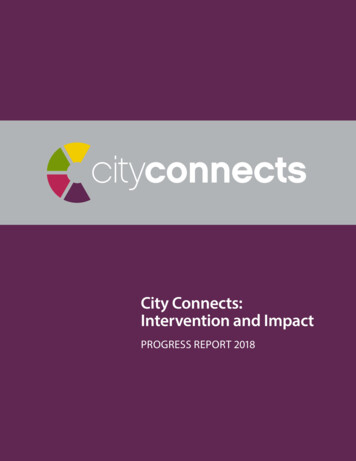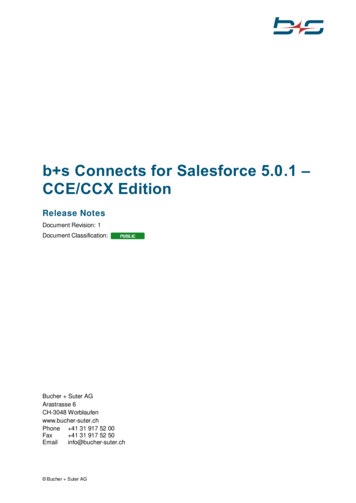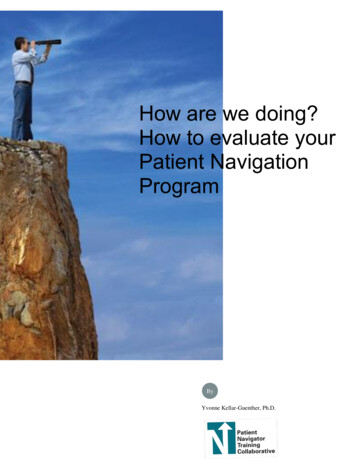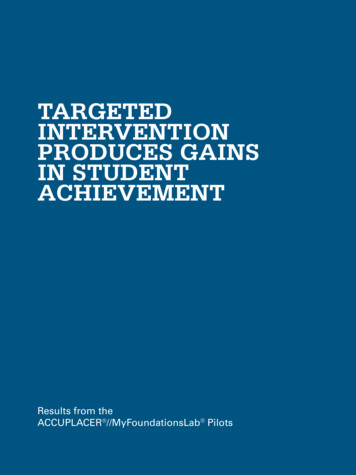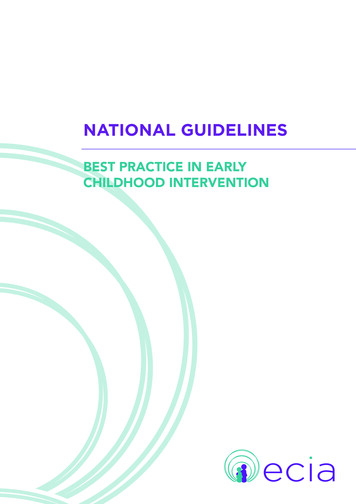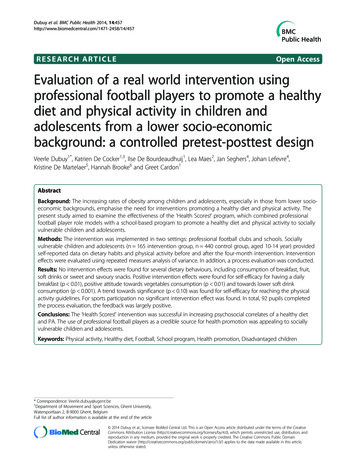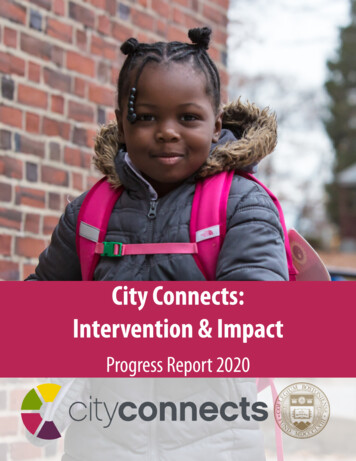
Transcription
City Connects:Intervention & ImpactProgress Report 2020
INTRODUCTION FROM THE EXECUTIVE DIRECTORWe are pleased to present the 2020 Progress Report for the City Connects intervention. The studies described inthis report reveal the many and varied positive outcomes resulting from the intervention. Across a wide age span,and on varied outcomes, findings confirm the power of integrated and systemic student support – specifically, theCity Connects intervention – to enhance opportunity and life chances for schoolchildren living in poverty.We release this report amidst a time of unprecedented challenge. A pandemic shuttered schools in late winter onalmost a moment’s notice. As this massive shutdown of schools and society happened, the value of a systemicapproach to student support was revealed in clear lines. As students departed to shelter at home, each studentalready had a customized plan for support developed earlier in the school year as part of the City Connectsintervention. This plan, documented in a secure online platform, provided administrators, teachers and supportstaff with deep knowledge about the strengths and needs of each student. It detailed the various services,resources and enrichment opportunities that each student was receiving from both the school and communityagencies. This tailored plan allowed these supports to be easily identified and, if possible, maintained oraccommodated. For community agencies, which were also shuttered, the child’s plan was redesigned in analternative and appropriate manner. City Connects Coordinators were positioned to continue their work ofsupporting students, families, and colleagues in a seamless fashion. In addition to helping children with obviousneeds for food, technology and internet access, Coordinators were able to respond to the “hidden needs” ofchildren in families stressed by job loss, homelessness, overcrowding, sickness, and grief.Now, as our communities seek justice and meaningful change following the deaths of George Floyd, AhmaudArbery, Breonna Taylor, and so many others, our work in schools continues. City Connects was developed to liftchildren over barriers to success, particularly in low-income urban communities. Our work with children andfamilies is anchored in a deep commitment to promoting justice, supporting one another, and tackling oppression.We are grateful to our City Connects Coordinators and Program Managers, who have demonstrated resilience,creativity, and dedication to our values as they have translated our school-based practice into a system of supportsand services delivered exclusively outside of school, during a time for which there has been no playbook and in acontext that cries out for justice.We are thankful for the support and collaboration of the public and private schools in which we work. We thankour partners in Boston, Springfield, and Salem, Massachusetts; Dayton and Springfield, Ohio; Minneapolis,Minnesota; Indianapolis, Indiana; Chattanooga, Tennessee; and Jamestown, New York. Across each of thesedistricts, we are grateful to the superintendents, administrators, principals, teachers, student supportprofessionals, data liaisons, and other school and district staff who have helped to introduce and implement CityConnects in their communities and enabled it to work effectively in their schools. We also thank our communitypartners, who are tireless in finding ways to reach out, collaborate, and deliver services to children and families.We gratefully acknowledge each of our funders as well as the Lynch School of Education and HumanDevelopment, Boston College. Their generous support of City Connects over many years has allowed us to servestudents in our hometown of Boston and beyond. Their commitment to this work has allowed us to continue ouroperations during this time that both challenges our society’s health and well-being as well as renews ourcommitment to support children and families who have suffered disproportionately from the pandemic andsocietal injustices.City Connects makes a difference for children, improving educational success and life chances. We are grateful toall who make this work possible, especially those responding “on the front lines” of this crisis. Although thecircumstances are difficult and the methods are new, we are extremely proud of and inspired by all that ishappening in our school communities. We are glad to have the opportunity to continue this work together.With gratitude,Mary Walsh
CURRENT AND PAST FOUNDATION SUPPORTBarr FoundationThe Better Way FoundationCatholic Schools FoundationChildren’s Aid SocietyFireman Charitable FoundationGHR FoundationJoy in Blue FoundationThe Charles Hayden FoundationThe Lookout FoundationThe Richard K. Lubin Family FoundationThe Ludcke FoundationThe Mathile Family FoundationThe Herman and Frieda L. Miller FoundationThe New Balance FoundationNew ProfitI. A. O’Shaughnessy FoundationAmelia Peabody FoundationThe Philanthropic InitiativeThe Sheehan Family FoundationStrategic Grant PartnersGOVERNMENT AND DISTRICT SUPPORTDepartment of Education, Institute of Education SciencesMassachusetts Department of Elementary and Secondary EducationBoston, MA Public SchoolsHamilton County, TN Public SchoolsJamestown, NY Public SchoolsSalem, MA Public SchoolsSpringfield, MA Public Schools
Table of contentsIntroduction . . . . . . . . . . . . . . . . . . . . . . . . . . . . . . . . . . . . . . . . . . . . . . . . . . . . . . . . . . . . . . . . . . . . . . . . . . . . . . . . . . . . . . . . . . . . . . 1The story of our growth . . . . . . . . . . . . . . . . . . . . . . . . . . . . . . . . . . . . . . . . . . . . . . . . . . . . . . . . . . . . . . . . . . . . . . . . . . . . . . . . . . . . 4Why City Connects? . . . . . . . . . . . . . . . . . . . . . . . . . . . . . . . . . . . . . . . . . . . . . . . . . . . . . . . . . . . . . . . . . . . . . . . . . . . . . . . . . . . . . . . 6Model and implementation. . . . . . . . . . . . . . . . . . . . . . . . . . . . . . . . . . . . . . . . . . . . . . . . . . . . . . . . . . . . . . . . . . . . . . . . . . . . . . . . .9Model . . . . . . . . . . . . . . . . . . . . . . . . . . . . . . . . . . . . . . . . . . . . . . . . . . . . . . . . . . . . . . . . . . . . . . . . . . . . . . . . . . . . . . . . . . . . . 9Context of implementation . . . . . . . . . . . . . . . . . . . . . . . . . . . . . . . . . . . . . . . . . . . . . . . . . . . . . . . . . . . . . . . . . . . . . . . 12Reviews and services . . . . . . . . . . . . . . . . . . . . . . . . . . . . . . . . . . . . . . . . . . . . . . . . . . . . . . . . . . . . . . . . . . . . . . . . . . . . . .14Outcomes for students . . . . . . . . . . . . . . . . . . . . . . . . . . . . . . . . . . . . . . . . . . . . . . . . . . . . . . . . . . . . . . . . . . . . . . . . . . . . . . . . . . . 19City Connects leads to higher elementary school test scores . . . . . . . . . . . . . . . . . . . . . . . . . . . . . . . . . . . . . . . 21Sustaining the positive effects of preschool during elementary school . . . . . . . . . . . . . . . . . . . . . . . . . . . . . 24Improving enrollment in and completion of postsecondary education . . . . . . . . . . . . . . . . . . . . . . . . . . . . . 27Impact on schools . . . . . . . . . . . . . . . . . . . . . . . . . . . . . . . . . . . . . . . . . . . . . . . . . . . . . . . . . . . . . . . . . . . . . . . . . . . . . . . . . . . . . . . . 31Principal satisfaction. . . . . . . . . . . . . . . . . . . . . . . . . . . . . . . . . . . . . . . . . . . . . . . . . . . . . . . . . . . . . . . . . . . . . . . . . . . . . . .31Teacher satisfaction and impact on teaching . . . . . . . . . . . . . . . . . . . . . . . . . . . . . . . . . . . . . . . . . . . . . . . . . . . . . . .33Impact on community agencies . . . . . . . . . . . . . . . . . . . . . . . . . . . . . . . . . . . . . . . . . . . . . . . . . . . . . . . . . . . . . . . . . . . 36Conclusions . . . . . . . . . . . . . . . . . . . . . . . . . . . . . . . . . . . . . . . . . . . . . . . . . . . . . . . . . . . . . . . . . . . . . . . . . . . . . . . . . . . . . . . . . . . . . . 38The role of teachers. . . . . . . . . . . . . . . . . . . . . . . . . . . . . . . . . . . . . . . . . . . . . . . . . . . . . . . . . . . . . . . . . . . . . . . . . . . . . . . . . . . . . . . 39
IntroductionAcross America, children in high-poverty urban schools face out-of-school challenges that impede their success inthe classroom and in life. In the 1960’s, the Coleman Report and others concluded that socioeconomic backgroundis a significant factor affecting students’ academic achievement (Harrington, 1962; Coleman et al., 1966). Currentresearch confirms that contexts beyond the school are critical, accounting for up to two-thirds of the variance instudent achievement (Phillips et al., 1998; Rothstein, 2010).The impact of poverty outside of school contributes to inequality in educational outcomes; in fact, Berliner (2013)identified poverty as the single most critical factor to address in education reform. The achievement gap related toincome has grown as the divide between the income levels of rich and poor families has widened (Duncan &Murnane, 2011; Reardon, 2013).Collectively, this work points to a straightforward conclusion: schools cannot close the achievement gap without asystemic approach to addressing out-of-school disadvantage (Bryk, Sebring, Allensworth, Luppescu, & Easton,2010; Walsh & Murphy, 2003). Yet, as noted by Carter and Reardon (2014), while much research has beendedicated to documenting the consequences of inequality, less has focused on what can be done to reduceinequality.City Connects emerged in response to the need for a systemic approach to addressing the out-of-school factorsthat can impede a student’s ability to succeed and thrive in school (Walsh & Brabeck, 2006). Its mission is to helpstudents—academically, socially, emotionally, and physically—by connecting each and every child to a tailored setof prevention, intervention and enrichment services in the school and community. When a school implements CityConnects, effective student support becomes central to its mission and day-to-day operations. The array ofservices and enrichments in the urban community also become central to the school’s role in supporting studentsand evidence becomes available for evaluating effectiveness.Starting twenty years ago in a single Boston Public school, the partnership among Boston College, school districts,and community agencies continues to grow. As the 2019-20 school year began, City Connects was in over 90 highpoverty urban public, Catholic, and charter schools across six states.During this period of growth, and especially in the past five years, interest in the work of City Connects and relatedinterventions has grown in the worlds of practice, research, and policy. Among practitioners, the work ofaddressing out-of-school factors that influence achievement and thriving in schools has come to be described as“Integrated Student Support” (ISS) (e.g., Moore et al. 2014, 2017). Research seeks to build on evidence for theeffectiveness of these interventions. A national research conference sponsored by the American EducationalResearch Association and hosted by Boston College in 2017 further called for investigation of how ISS works,including the relative importance of different elements and features of specific interventions and the influence of,and impact on, the context of implementation (Center for Thriving Children, 2018). National education policynow not only encourages implementation of ISS but also allows the use of Title I funds for efforts that include ISSCity Connects: Intervention and Impact / Progress Report 20201
(Every Student Succeeds Act). Many states are currently promoting evidence-based ISS for their districts,including five that have filed or passed legislation enshrining ISS in state education policy (America’s Promise).Evidence demonstrates that being in a City Connects school makes a difference for students. In elementaryschool, students in City Connects schools significantly outperform their peers on report card scores in reading,writing, and math (Walsh et al., 2014). After leaving City Connects and moving on to middle school, studentsscored higher on statewide math and English language arts tests than comparison peers who were never enrolledin a City Connects school (Walsh et al., 2014). Students previously enrolled in City Connects elementary schoolslater demonstrated lower rates of chronic absenteeism and dropped out of high school at about half the rate ofcomparison students (City Connects, 2014).While the consistency of these findings across methods, samples, and sites argues that City Connects is not merelyassociated with, but causes, these benefits for students, a new study further supports the claim of causality. Asdescribed in this report, students randomly assigned to City Connects schools via a school choice lotterydemonstrated significantly higher statewide test scores by grade 5 than peers who were not randomly assigned toCity Connects. This study represents the first large-scale randomized controlled trial of an integrated studentsupport intervention serving elementary schools.New studies have expanded the range of evidence that City Connects matters for children and youth. Preschoolstudents who later enrolled in City Connects schools significantly outperformed former preschool students whonever received City Connects in academic achievement in elementary school. Further, new findings reportedbelow demonstrate that after leaving high school, students previously enrolled in City Connects schoolssignificantly surpassed comparison peers in both enrollment and degree completion at two- and four-yearcolleges. Together, these recent findings support the claim that rigorous integrated student support can sustainthe benefits of other supports (such as preschool) and yield long-lasting enhancements of life chances.With this body of evidence demonstrating effectiveness, it is important to consider the features distinguishing CityConnects from other approaches to providing comprehensive, integrated student support to students. While itshares characteristics with various other models, several features of City Connects are distinct:Grounding in developmental science. Several decades of theoretical and empirical research on the nature of childdevelopment have informed both the development of City Connects and its continuous improvement. Thisgrounding helps ensure that the model is sensitive to, and responds to, the reality of how children grow and howthey can best be supported.Attention to four developmental domains to understand root causes. City Connects seeks to understandindividual children’s strengths and areas of challenge in academics, social/emotional/behavioral, health, andfamily domains. In seeking this understanding, City Connects builds on its grounding in developmental science todetermine not just the surface issues, but the underlying reasons for any challenges. 2020 Trustees of Boston College, Chestnut Hill, Massachusetts2
Awareness of both strengths and needs of each child. Developmental science also supports City Connects’ focusnot only on individual needs but also on a child’s strengths as a key strategy to promote positive development.Belief in schools as the epicenter of support. Based on a deep and ever-evolving awareness of how schools work,City Connects offers a way to transform structures and roles that are already present in a school, making themmore effective and efficient in their support for students.Highly-trained coordinator of student support. In every City Connects school, a Master’s-trained school counseloror social worker, holding state licensure in his or her field, serves as a City Connects Coordinator. Theserequirements ensure that the Coordinator has the professional skills needed to identify root causes that can revealwhich supports will most benefit a student.For each student, a tailored support plan that reflects the teacher’s input. Through a defined and documentedprocess that is supported by a proprietary software system, every year, each student in the school receives acustomized support plan. The City Connects Coordinator meets with each teacher individually to discuss everystudent in the class. In light of each student’s unique strengths, needs, and interests, a support plan is drafted.For students at significant risk, an in-depth review and goals. When the teacher or anyone in a City Connectsschool has significant concerns about a student, the Coordinator initiates a structured process for an in-depthreview. This meeting involves school staff representing multiple professions, such as teachers, student supportstaff, and school administration.Defined paths of collaboration with families and community agencies. Cultivating and maintaining communitypartnerships is a key aspect of the Coordinator role. The City Connects practice and its software make it possibleto identify appropriate school- and community-based supports for students and to collaborate with families indecisions about services, referrals, and delivery.Fidelity monitoring system. Through the proprietary software system, information can be automatically compiledto show the degree to which City Connects is being delivered in any location and network-wide. Developed withreference to research in implementation science, the system supports scaling and sustainability.Positive outcomes for students, schools, and communities. Strong evidence points to City Connects’ effectivenessin supporting positive outcomes for children and youth, both in academic achievement and indicators of lifechances. With the addition of a randomized controlled trial involving thousands of students, this research isamong the strongest support available for the effectiveness of ISS. Annual anonymous surveys show high levels ofsatisfaction among principals, teachers, and community agencies.This progress report provides an in-depth description of the features that distinguish City Connects from otherapproaches. We offer this report in response to both the growing momentum to find practical and evidence-basedways to support students’ out-of-school needs and the research agenda seeking to identify the essential elementsof comprehensive student support.City Connects: Intervention and Impact / Progress Report 20203
The story of our growthSince its inception in the 1990s, City Connects has grown from a local collaboration to a national model ofintegrated student support. As an intervention that values evidence, City Connects has collected and analyzed dataon its effectiveness. As discussed below, a consistent set of findings shows that City Connects makes a differencefor students.START UPThe partnership that led to City Connects began when researchers and school and community leaders jointlyrecognized that out-of-school factors have a significant influence on students’ experience in school. Principals andteachers observed that efforts to address these factors in school were often unsystematic, lacking an organized wayto coordinate the rich resources of the community. Agencies reported a need for established connections toschools. At the same time, researchers pointed out growing evidence from the developmental sciences that couldinform effective ways to address this problem.Together, educational and community leaders and researchers began to develop a collaborative way to supportstudents by addressing the out-of-school factors impacting student success and thriving in school. Drawing oneffective practices emerging at the time, the team met with school principals, teachers, school and district staff,community agency representatives, and families to define a practice systematizing the work traditionally done inschools by school counselors, nurses, psychologists, community partners, and others. The resulting system,designed to permit data collection and measurement of outcomes, was initially implemented in Boston schools inthe 2001-02 academic year.REPLICATEThrough its gradual expansion, City Connects has proved to be replicable. Its first expansion, in 2007-08, was toseven schools in a new geographic area of the city of Boston. The following year, City Connects launched in severalurban Catholic schools in Boston. It also expanded outside of the Boston area, to a distant site in Dayton, OH. Twoyears later, City Connects’ success led to the program’s launch in “Turnaround” (consistently low-performing)schools in the Boston Public district, as well as public schools in Springfield, MA.During this replication phase, City Connects’ evidence base grew dramatically, demonstrating that City Connectsstudents outperform their peers in measures of academic achievement in elementary school, with benefitspersisting into middle school, high school, and beyond.SCALEAs City Connects’ evidence base has expanded, interest in City Connects as a comprehensive approach tosupporting all students has grown nationally and internationally. It is currently implemented in 91 public, charter,and Catholic schools across six states. In the 2018-19 school year, over 26,000 students were served. 2020 Trustees of Boston College, Chestnut Hill, Massachusetts4
City Connects is now recognized nationally as a comprehensive approach to student support that can be deliveredat low cost and that yields significant, positive outcomes for children’s achievement and life chances.Most recently, City Connects has begun collaborating with civic leaders in the North East Inner City (NEIC)neighborhood of Dublin, Ireland. The Irish Department of Education and Skills and Department of Children andYouth Affairs, together with the NEIC community, are leading an effort to launch City Connects in ten Dublinprimary schools in fall 2020.Figure 1 illustrates the growth and development of City Connects.FIGURE 1. Timeline of City Connects' expansionCity Connects: Intervention and Impact / Progress Report 20205
Why City Connects?Every student deserves the opportunity to learn and thrive in school. However, what happens outside of schoolcan greatly impact what happens inside of school. For students living in poverty, out-of-school factors can bepervasive and severe. Students and their families may struggle with hunger, housing, medical issues, or otherneeds. A lack of time or resources may mean that needs remain unmet and connections that would benefit astudent or a family are not made. While schools and districts increasingly recognize the need to address thesefactors that affect learning and thriving, they often lack a systematic way of doing so.City Connects offers an approach to addressing these out-of-school factors that is grounded in developmentalscience. Four core principles of effective practice emerging from the developmental sciences have informed thedevelopment of City Connects and guide the work of addressing the out-of-school factors that impactachievement.COMPREHENSIVEChildren develop across biological, psychological, and social domains (Bronfrenbrenner & Morris, 2006; Ford &Lerner, 1992). Each domain is simultaneously impacting each of the other domains (Rutter, 2007). For thisreason, student support must take different developmental domains into account. At the same time, children’sneeds span a continuum of intensity, from mild to severe. Therefore, student support must be offered at variouslevels of intensity: prevention, early intervention, and intensive/crisis intervention (Adelman & Taylor, 2006).CUSTOMIZEDChild development is dynamic and complex, and each child experiences a unique interaction between personalcharacteristics and environment (Cicchetti & Sroufe, 2000). As a result, no two children’s experiences ordevelopmental trajectories are identical (Sameroff, 2009). Also, developmental science points to the value ofaddressing children’s strengths in addition to their needs, creating conditions for resilience (Masten & Tellgen,2012). Thus, to be effective, student support practices must tailor approaches in ways that take into account theindividual strengths and needs of every student in a school.COORDINATEDDevelopmental science points out the mutually influential relationships among a child and his or her home,school, and neighborhood (Bronfenbrenner & Morris, 2006). Aligning efforts across these contexts is especiallyimportant for children at economic disadvantage (Dearing et al., 2016; Garcıa Coll et al., 1996). For example,given the critical role of families in children’s development, it is important that student support plans becoordinated with family collaboration. Also, effective student support involves an assessment of strengths andneeds with teacher input. To provide the full array of supports students need, schools should leverage the work of 2020 Trustees of Boston College, Chestnut Hill, Massachusetts6
providers and resources from the community (Brabeck & Walsh, 2003; D’Agostino, 2013). Coordination requirescommunication and systems for aligning the efforts of these people and groups.CONTINUOUSDevelopmental science suggests that continuity of care in a safe, predictable, and stable environment positivelyimpacts development (Waters, Weinfield, & Hamilton, 2000). Implementation of student support should promotethis continuity and stability. Further, connecting students to the supports that best match their evolving strengthsand needs is an iterative process because development is dynamic and changes over time. For example, earlychildhood experiences affect what happens in elementary school and beyond (National Research Council andInstitute of Medicine, 2000). As a result, children may need varying levels of support across the continuum oftheir development. Developmental science makes clear that, given appropriate attention to contexts, the course ofa child’s development can be altered and enhanced.City Connects operationalizes these principles in its specific model for student support. As a comprehensiveapproach, City Connects considers the overlapping impact of four developmental domains—academic, social/emotional, health, and family—on children’s readiness to learn and thrive in school. This comprehensive approachmakes it possible to seek the root cause behind an apparent challenge and respond appropriately. For example,what surfaces as an academic need may have social-emotional roots. See Figure 2.FIGURE 2. The interaction of children’s developmental domainsSupports and services are identified in all of these areas at the levels of prevention/enrichment, early intervention,or intensive intervention.The City Connects practice considers both strengths and needs of every student in a school across these domains,and connects each to services at appropriate levels of intensity in a customized way. The practice ensures thateach and every child in a school is considered individually to find the unique combination of supports and servicesCity Connects: Intervention and Impact / Progress Report 20207
that will help that child thrive. Customization makes it possible to respond to an identified root cause behind achallenge observed by teachers and others in the school. For example, if the comprehensive review of a student’sstrengths and needs reveals a possible social-emotional cause for an academic struggle, then offering a socialemotional support—for example, a leadership opportunity or a social skills group—may lead to academicimprovement.Customization also occurs at the level of the school. Research indicates that the climate and overall socialconditions of schools have consequences for academic development (Berkowitz et al., 2017; Thapa et al., 2013). Towiden opportunities for enrichment, for prevention purposes, and also in cases when a need becomes evidentwithin or across entire grade levels, supports are brought into the school to serve large numbers of students.City Connects is coordinated, structurally linking districts and schools with community partners to make availablethe full array of supports and services students may need, as shown in Figure 3.FIGURE 3. The City Connects partnershipThis partnership includes structures to enable coordination. For example, core processes ensure teacher input in areview of strengths and needs of every child, close collaboration with families in developing and carrying outindividual support plans, and regular communication with community agencies providing services.Finally, to ensure that student support is continuous, City Connects developed a practice in which the individualstrengths and needs of every student are reviewed every year, and in which a secure, proprietary database makes iteasy to follow up on each student’s service referrals and progress throughout the school year and across years.While it isn’t possible to predict what events might take place in a student’s life, it is possible to respond withconsistency and care. 2020 Trustees of Boston College, Chestnut Hill, Massachusetts8
Model and implementationModelThe City Connects approach for collaborating with a school district to implement its model is grounded in theliterature on implementation science informing sustainable interventions (Foley et al., 2015). Beforeimplementation, a steering committee is formed, typically in the spring, with representation from both CityConnects and the district. The committee engages in several stages of planning. First, City Connects works withthe district to conduct a needs assessment, seeking the input of principals, teachers, families, students, andcommunity agencies to understand current strengths and needs in the area of student support. An environmentalscan identifies a range of agencies and resources in the community. Next, City Connects reports findings to thedistrict and, if the district decides to move forward with implementation, provides infrastructure and supports,in
Starting twenty years ago in a single Boston Public school, the partnership among Boston College, school districts, and community agencies continues to grow. As the 2019-20 school year began, City Connects was in over 90 high-poverty urban public, Catholic, and charter schools across six states.
